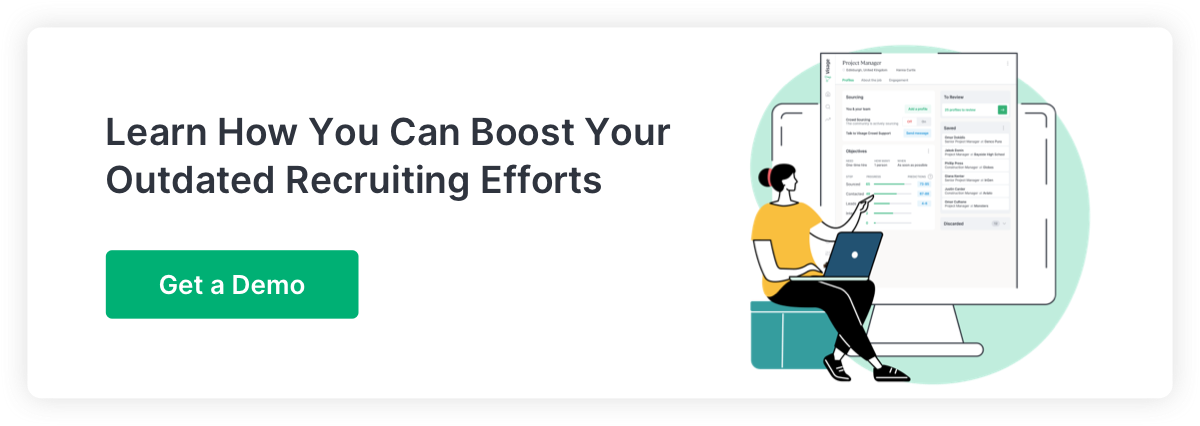Workplace burnout affects organizations of all sizes and across all industries. In the world of recruiting, however, burnout is running especially rampant.
Jobvite’s annual survey reveals 61% of recruiters report more stress at their jobs, with 19% of those describing the increase as “drastic.” A stiff hiring market makes the fight for talent fierce, and recruiters must work overtime to find candidates and fill open roles quickly.
We cover many of the finer details in our Recruiter Burnout webinar.
The standard tools and processes already in place to help recruiters actually do little to help ease their workloads.
This means that many recruiters are facing higher levels of stress and burnout than ever before. Organizations must find solutions to address recruiter burnout before it costs them their best talent.
Today, we break down six tools and strategies organizations can implement to help combat recruiter burnout. We’ve learned these strategies through years of working with our clients, hearing about their goals and the obstacles they face in meeting them, and developing new solutions and strategies to help them get there.
Causes of Recruiter Burnout
Out of the number of leading causes of recruiter burnout, discovering which ones have the greatest effect on your recruiters is the key to finding the right solution.
Recruiters often report feeling burned out as a result of the following:
- Macroeconomic factors (low unemployment, high job vacancy)
- Sub-par recruiting tools
- Poor recruitment practices and training
- High employee turnover
- Lack of a dedicated recruiting team
- Existing recruiters overworked with high req loads or admin responsibilities
- Recruiters being expected to source when it isn’t their job
Types of Recruiter Burnout
By analyzing the causes of your recruiters’ burnout, you can identify their particular type of burnout, which is your next step.
The major types of burnout include:
| Overload Burnout | A surefire path for any worker to get burned out is to overburden them. For recruiters, this usually results from a less-qualified applicant pool, overcomplicated administrative workflows, and/or understaffed recruiting department. |
| Mismanagement Burnout | When a recruiting team is mismanaged, it leaves recruiters feeling helpless. A lack of lead sources, sub-par recruiting/workflow management tools, and poor training can make recruiters feel that they don’t have the tools they need to do their jobs. |
| Under-Challenged Burnout | Working in a monotonous, repetitive environment will eventually drain recruiters of motivation. Working with the same types of applicants, the same recruiting scripts, and using the same communication channels leads to burnout because the job tasks become too simple and similar. |
Now that you know what to look for and the main causes of burnout, let’s dive into some solutions, as promised.
1. Lean On Automation Tools
One of the most significant factors contributing to recruiter burnout is the sheer number of monotonous tasks and time-consuming steps recruiters must accomplish daily.
Whether updating candidate profiles after calls, performing outreach tasks, or parsing resumes for potential candidates, recruiters are swamped with menial tasks that quickly fill up their days.
45% of recruiters say that #AI will improve their job performance and help them become more efficient. See how AI and #Automation can help you reduce the likelihood of recruiter burnout via @Visage_jobs
But monotony doesn’t need to be the norm. Many of these repetitive steps can be automated.
Your recruiters have mission-critical work that should fill their days, rather than spending so much time on administrative tasks.
And these tedious chores don’t need to be the primary stressors that cause fatigue and leave your team feeling burned out.
Instead, your team can delegate these tasks to the tools in your tech stack, so they can free up their time for the work that matters — engaging with and nurturing candidates throughout your hiring pipeline.
When your organization embraces automation, you can combat recruiter burnout by:
- Minimizing repetitive tasks
- Streamlining administrative processes
- Reducing unnecessary tools and tech
- Decreasing the chance of errors
- Improving efficiencies and communication
It’s time to give your recruiters a breather. See what options are available to optimize your team’s workload so they can focus on their core functions.
2. Embrace Intelligent AI
Artificial intelligence is still gaining popularity. While many companies may still scrutinize AI based on ethics or security concerns, organizations across every industry and in every part of the world understand the benefits of having an intelligent, responsible AI-powered tool in your arsenal that learns alongside your processes.
Tools built with AI can make your life easier now, and they can learn to return more accurate responses to better meet your company’s needs as time goes on.
Artificial intelligence is one of the hottest topics, period. In a recent study, 62% of recruiters said that they are optimistic about AI’s effect on recruiting. The remaining population may have some concern about worker displacement, but it is far more likely to result in better job satisfaction for recruiters than it is to replace them. The top 5 benefits of AI that survey respondents identified all included things that allow recruiters and AI to work together for better results on tighter timeframes:
- Faster/Easier to write job descriptions
- Automate administrative tasks to provide more time for more engaging work
- Removing daily mundane tasks
- Improving overall productivity
- Faster/Easier to engage with candidates
Beyond that, AI is helping companies level the playing field and access capabilities once considered unrealistic for many organizations.
When it comes to artificial intelligence, strategy is the name of the game. Creating a thoughtful, logical plan for implementation will set your company up for greater success than making a spur-of-the-moment decision.
While many companies have begun relying on AI for support, we’ve only seen the tip of the iceberg. Moving forward, AI-powered technologies will become increasingly useful.
Now is the time to start your research and determine how best to leverage these tools for heightened levels of success.
There are some legal concerns to note when using AI, so you’ll need to ensure the tech you use complies with regulations to ensure fair hiring practices.
Visage uses humans to find top talent, and our AI ensures a quality match, so you can rest assured that we find top talent and maintain compliance with all regulatory requirements.
The way we source and engage talent has changed in this post-COVID world.
See what methods are working for recruiters today.
3. Ditch Outdated, Clunky Tools
Legacy tools may seem like a smart move since there is no large investment or time lost with implementation. But in reality, outdated tools can actually harm your team’s productivity rather than boost it.
If your team is stuck using tools that aren’t fully utilizing the tasks they need or offer the support they crave, then the risk of burnout and fatigue is much greater.
It’s time to ditch those clunky, difficult-to-use tools. Instead, you’re much better off investing in updated tech that performs at the levels you need.
Not only will your team accomplish their jobs more efficiently, but you’ll enjoy the added benefits of strategic, real-time insights into the effectiveness of your company’s processes.
Technology can be (and will be!) your best friend and secret weapon to combat and prevent recruiter burnout. Take the time to ensure your tech stack is equipped with the most cutting-edge software.
Companies need to combat #RecruiterBurnout head-on. See how you can reduce the strain on your team with these 6 tools and strategies via @Visage_jobs
4. Invest In Project Management Tools
Project management tools do more than just offer insights into the status of tasks. They give you a glance into the workload of your employees, so you can quickly and easily see whether any of your team is maxed out on bandwidth.
Often, it’s hard to accurately estimate the amount of work an employee is assigned in a given week. And, since each employee works at a different pace, it can be challenging to divide the work among your team members fairly.
When you invest in a strong, intelligent project management platform, you can see just how long it takes for your team to accomplish any given task. What’s more, today’s project management tools often have built-in functions and capabilities like:
- Task scheduling and planning
- Time tracking and task prioritization
- Project budgeting
- Analytics and reporting
- Team collaboration
These functions can help identify barriers to productivity and nip potential burnout in the bud.
With one glance, you can see whether team members are lagging or feeling overwhelmed in their roles. Then, you can delegate tasks to help balance workloads and reduce the strain on any given employee.
5. Find and Use Internal Communication Platforms
One of the best ways to tackle burnout is by being honest and transparent with your team. After all, if you don’t communicate with one another, how can you know if someone is feeling overwhelmed?
Investing in a strong internal communication tool is crucial to your team’s success.
It provides a dedicated channel for communicating their needs, talking through struggles they’re facing, and building rapport with one another. Because so many organizations have embraced a hybrid or fully remote work environment, communication platforms are no longer a “nice-to-have”: they’re a must-have.
Aside from offering a platform to talk openly about your workload and bandwidth, communication platforms have become the equivalent of the modern-day water cooler.
This is the space where team members share fun quips about their weekends, offer best practices and insights, and generally take a break from daily tasks.
At Visage we use Slack, and aside from channels dedicated to company updates, departments, or special projects/alerts, we also channels dedicated to showing off our pets that invade our home offices and weekly trivia challenges!
6. Integrate Your Tools With Visage
AI and automation might be revolutionizing the world of recruiting, but without the human intelligence behind these tools, you’ll fail to capitalize on the true benefits.
At Visage, we understand the importance of human interaction, which is why we pair our tools with sourcing experts to retain a human touch in the overall recruitment process.
Our team has over 4,000 certified and trained sourcers available 24/7. Our experts span every industry around the globe. When you combine this human intelligence with our AI-powered platform, you’ll have qualified, talented candidates on your desk in hours.
And the best part? You can trust that every candidate has been reliably sourced, vetted, and matches your exact needs.
It’s time to ease the burden on yourself and your recruiters. Take the first step by expanding your sourcing and engagement capabilities with our intelligent global platform.
To learn more about how Visage can help you reduce recruiter burnout within your team, check out our recruiter burnout whitepaper or reach out to us for a demo.

Kevin is a seasoned Customer Success Manager, specializing in optimizing hiring processes and driving talent acquisition success for clients. He hails from Ireland, has lived in Portugal, and backpacked through the US, Central America, and South America. Besides his love of traveling, he adores all things sports, movies, and stand-up comedy.

